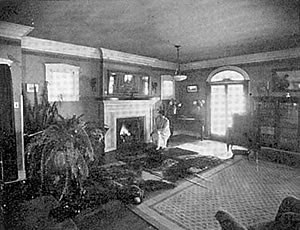Blakeland and the Coffee Pot Restaurant
Homesteads grew up all around Littleton in the early years of the town's history. The area known as Blakeland was located approximately four miles south of Littleton. Mrs. Ethel R. Blake originally owned about 480 acres in the area. In 1927, Ethel Blake defaulted on the loan for her property, prompting a Public Trustee Sale of her land. The Blakeland property was sold and became a farm known as the Diamond K Ranch, specializing in poultry, cattle, sheep, hogs and cows. There were more than 5,000 pure-bred birds on the ranch, including the following breeds: White Leghorns, Barred Rocks, Rhode Island Reds, Musckovic ducks, geese and turkeys. Several thousand eggs were hatched every season. Blakeland's principal production was in eggs, and a number of leading Denver restaurants had contracts with Blakeland for eggs and poultry.
The Diamond K Ranch was owned by Frank E. Kistler. Kistler's interest was in breeding racehorses and he owned several successful thoroughbreds. His horse, "Buttin In" finished second in the Kentucky Derby in the late 1920s. In 1931, Fred A. Bemis became the trainer for the racehorses. During the summers, the horses traveled to county fairs to be entered in races and steeplechases.

Mrs. Mary N. Blake sits in front of the fire in the living room of her country home. c.1938.
Mrs. Mary Blake, one of Ethel's relatives, maintained the original house with its furnishings, and she built a restaurant nearby to earn a living. It is not known what happened to Ethel Blake. The restaurant was called the Coffee Pot Restaurant, and a large coffee pot stood on the roof of the building to symbolize the restaurant. The coffee pot was unique in that it was connected to a pipe running up through the chimney that formed the spout of the coffee pot. Smoke was emitted from the spout, making it look as though the coffee pot was working.
The interior of the restaurant was decorated with many of Mrs. Blake's personal possessions including valuable oil paintings, hand painted Chinese plaques, decorative lanterns and other objects. Because of the uniqueness of this restaurant, the Coffee Pot became a popular dining experience known throughout the area.
One Friday night in May, 1931, the well-known Colorado historian, Dr. Leroy R. Hafen, gave a party at the Coffee Pot for 40 friends and acquaintances. They had an enjoyable time, until a fire broke out somewhere in the restaurant. The men in the party tried to help, but to no avail. The Littleton Fire Department was notified and quickly sent out a truck, even though the Coffee Pot was outside the boundaries normally covered by the Littleton Fire Department. The first problem the firemen faced was finding water for the hoses. Mrs. Blake told C.E. Stephenson, who was in charge, that the city ditch ran nearby, but that a fence and a plowed field stood in the way. It seemed impossible. But the Littleton "hose boys" ran 1400 feet of hose all the way to the city ditch and were able to pump water continually until 4:30 in the morning.
This fire proved terribly destructive. One of the firemen, Billy Scott, was overcome by smoke and collapsed. False reports that he had died caused Mrs. Blake to become hysterical. Then a waitress, Mrs. Minnie Burkett, passed out from smoke inhalation and was carried to safety by the hose boys. Mrs. Blake suffered a great deal of stress over the fire, which burned the building to the ground. All of the interior decorations were lost, the kitchen equipment, the refrigerator, furnace, stove and plumbing system were destroyed. Four of her most important silver pieces were also destroyed. Only the dishes in the banquet hall were saved, along with odds and ends. The large coffee pot on the roof stood throughout the fire, but by the time the fire was out, the coffee pot leaned forward tentatively on the weakening roof. Two days later, the coffee pot fell to the ground.
In her distress, Mary Blake did not know whether she would rebuild. She also wrote poetry and prose and considered doing that full time instead of operating the restaurant. The insurance she carried was not enough to pay for rebuilding the restaurant. She had experienced her share of bad luck, first when Ethel R. Blake lost her farm, and then with the destruction of her restaurant. Her friends and even the Littleton Independent urged her to rebuild, "Blakeland and the Coffee Pot could not be without Mary Blake."
Just two weeks after the fire, several offers to rebuild the Coffee Pot had been made. By the end of June, Mary Blake had decided to rebuild the banquet hall at Blakeland, and was "planning to reopen it by July fourth. This is the only building that was not entirely destroyed by fire." The property was valued at $25,000, and the remodeling estimate was $1,000.
A newspaper ad on July 17, 1931 declared the Coffee Pot open and offering the same delicious meals as before the fire. Also at Blakeland Park, groups could have picnics and play miniature golf "under the trees." It is doubtful whether the large coffee pot was returned to the roof, as the ad finished by stating to look for "The Sign of the Coffee Pot."
Bibliography
Littleton (Colo.) Independent. The Littleton Independent Publishers, 1888-
Littleton Independent. The Story of Littleton, Denver's Best Suburb, Golden Jubilee Number, July 22, 1938. Littleton: Littleton Independent Publishers, 1938.
Photographs courtesy of the Littleton Museum unless otherwise noted. To order copies, contact the museum at 303-795-3950.
Compiled by Rebecca Dorward
Edited by Phyllis Larison and Lorena Donohue
Updated April 2021 by Phyllis Larison